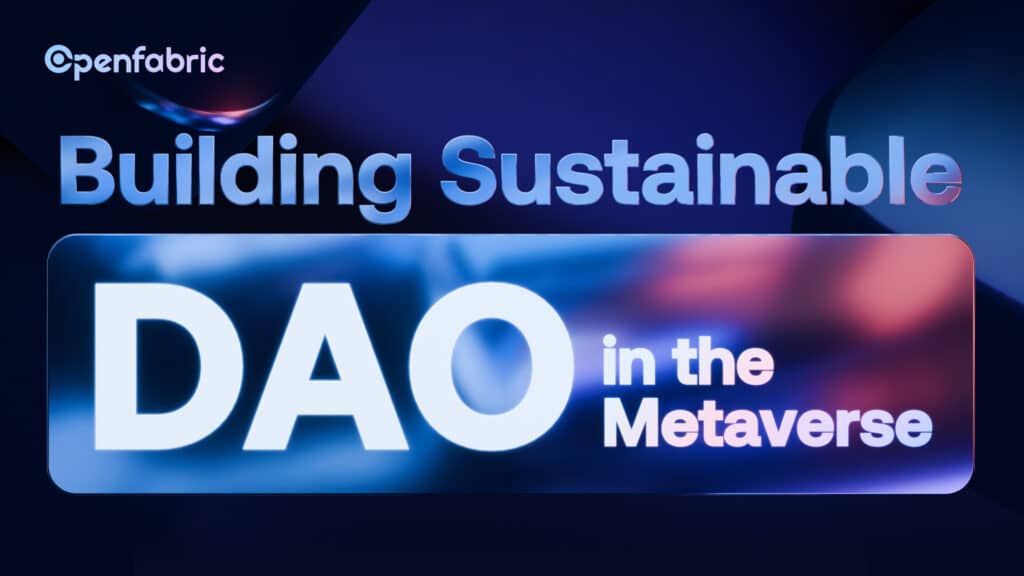
September 13, 2024 8 minutes read
Building Sustainable DAO in the Metaverse

The Metaverse is a community where the digital world meets reality. It is a growing community that encompasses entertainment, commerce, learning and other forms of social interaction. And as with every community, there has to be a leadership process for decision making and coordination of the affairs of the community, this is where Decentralized Autonomous Organizations (DAOs) come in. DAOs in the Metaverse represent the democratic leadership in the Metaverse where everyone is involved in the decisions taken by the community.
Every day, there is an increasing number of individuals carrying out an activity on the Metaverse. It is an ecosystem with significant potential worldwide. Experts project that by the year 2030, the number of users in the Metaverse will be up to 2,633 million users. This increase further highlights the need for sustainable DAOs in communities in the Metaverse because they represent the present and the future of the Metaverse.
For us to build something, we must understand how it works, the levels it works best and gain a general understanding of it. In this article, we will explore the concept of DAOs in the metaverse and we will see how they are shaping the future of blockchain technology.
Let’s get started
How DAOs operate in the Metaverse
As we noted earlier, DAO stands for Decentralized Autonomous Organization. It is a decentralized blockchain management or decision making system that is designed to disperse the power of governance amongst token holders in the web3 ecosystem. These tokens are called ‘governance tokens’ and they may give an individual the right to vote. As a general rule, the higher the token, the more voting rights an individual possesses. Nevertheless, the decision-making still involves other members of the community or organization.
In the metaverse, DAOs create a sense of inclusivity and ownership for members of the community. The smart contracts stored on a blockchain entirely run the voting process. The decentralized nature of the metaverse makes way for the vast adoption of DAOs. They will be more important with the growing number of users of the metaverse where accountability and transparency will be key to the survival of the metaverse.
Furthermore, smart contracts allow for automation of blockchain transactions in a decentralized ecosystem like the Metaverse. This automation makes transactions faster, more accurate and reduces cybersecurity risks.
In addition, DAOs are open to participants from all over the world. Therefore, the decisions taken are unbiased. This encourages worldwide participation of users and innovation within the metaverse.
Therefore, DAOs allow individuals in the Metaverse to make decisions by themselves without the control of a single governing body.
Challenges encountered by DAOs in the Metaverse
Despite being a revolutionary innovation, the concept of DAOs in the metaverse is not without its own fair share of problems. These problems cut across legal to individual issues and even challenges within the Metaverse ecosystem itself. Like every innovation, understanding its challenges will help you utilize it better as some of these challenges may be limitations to its use.
This section explores some of the challenges that follow the use and adoption of DAOs in the metaverse.
Let’s dive right in.
- Technological changes: Rapid technological advancements and innovation poses a threat to how sustainable DAOs are in the metaverse. As technology changes, DAOs must stay ahead of the curve to remain relevant. In addition, DAOs must leverage the new technologies and products to maintain their position.
- Legal and regulatory restrictions: Unfortunately, due to its decentralized nature, there is no central governing or regulatory body regulating the activities on the metaverse. This makes them a primary target for cyber criminals and fraudsters. As a result, cybersecurity breaches and other illegal activities may be irreversible. This often leaves victims of such illegal activities at a huge loss. Local laws and regulations may affect some of the implementations of DAOs when it comes to the metaverse. For instance, users may find it difficult to get the full experience with metaverse in countries where blockchain-based transactions are prohibited.
- Source of funding: The cryptocurrency and token market is fairly volatile. Only by careful analysis can investors confidently make investments involving tokens. This has a crippling effect on the metaverse and in turn DAOs as most investors often avoid investing in such projects. However, established metaverse platforms may not face this because they are trusted and in addition to external investors, they have other sources of generating income for the project.
How to Build Sustainable DAOs in the Metaverse
DAOs are increasingly becoming popular in the metaverse ecosystem. Unfortunately, not all of these platforms are sustainable. For a DAO to be sustainable, here are some things to consider.
It must have a sustainable governance model
Governance model relates to the structures and mechanism by which a DAO is defined, coordinated, and managed. It also includes the procedures or steps of decision-making and resources deployment. Evaluating the success of a DAO requires one to incorporate a good governance model that ensures its decentralized operations are transparent and its members have a say through voting.
A good governance model also involves the decentralization of its decision making. This implies that a single body does not hold the power of decision making; rather, it is decentralized. It prevents focusing on a few individuals, thereby encouraging more participation from others and fostering new innovation.
Transparency and accountability form another part of measures needed for a sustainable governance model as well. Members of the DAO must be kept in the know about everything done, decided, and transacted.
It must be environmental friendly
To preserve the integrity of our natural environment, everything we do must be environmentally friendly. This doesn’t exclude DAOs.
DAOs need to embrace environmentally friendly practices as a way of minimizing energy consumption. One of them is to deploy energy-efficient blockchain protocols that can decrease energy consumption rates. You can do this using Proof of Stake (PoS) models that are significantly more efficient than Proof of Work (PoW).
Proof of Stake requires less computational power. As such, its mechanism ensures the conservation of energy significantly.
It must be economically viable
DAOs must be economically sustainable to continue operating, scale and create value for the members. Some key components of a sustainable economic model can be transaction fees, members’ subscription, and sponsored content.
Proper token distribution and usage, or tokenomics, are also crucial. They determine how the DAO’s native token is used and can manipulate it.
Boosting more engagements in entrepreneurship and innovation within the DAO framework can also boost its economic possibilities. Thus, enabling members to access funds and materials can allow them to come up with new innovations that contribute to society’s welfare.
DAOs must be inclusive
For the proper functioning of DAOs in the Metaverse, it must be inclusive, diverse and equal to its members. They may do this based on the formulated policies and practices they adopt in the promotion of a healthy work environment.
DAOs can also show that they are being socially responsible by supporting social causes and charity related endeavors. This may involve working with other firms, engaging in development projects or conducting fundraising activities for societal causes.
DAOs can also promote empathy and collaboration and cooperation. Encouraging the community to engage in a lot of listening, as well as constructive communication and feedback, can help to achieve this.
They should be able to scale technically
DAOs have to be technically scalable in order to be able to accommodate the growing membership base, high levels of transactions and coming functionalities. DAOs can realize this with the help of applying layer 2 scaling solutions, sharding, or off-chain transactions..
This enables DAOs in the Metaverse to incorporate new technologies and service options. Thus, making sure that the user experience is as simple as possible and remains central most importantly for uptake.
In order to maintain their technical scalability, constantly check and fix performance and security if required. This involves software updates, fixing of bugs and penetration testing among others.
Furthermore, the utilization of artificial intelligence and machine learning promotes the efficiency of decision making as well as provides automation to the work.
The Future of DAOs in the Metaverse with Openfabric AI
The aim of Openfabric AI is to make AI more accessible, and push the boundaries of AI innovation. Due to its distributed structure, it supports secure sharing of data and model collaboration which eliminates the need to rely on authorities. Just like DAOs the platform is decentralized.
Therefore, Openfabric AI tools and applications can significantly influence DAOs and the Metaverse in general but with an extra touch. It brings ‘automation’ to the table.
Openfabric AI can significantly influence DAOs in the Metaverse in several ways:
- Decentralized AI decision-making: Openfabric AI can enable DAOs to apply decentralized AI models for prediction and decision-making. Therefore, choices made would be more informed and collective.
- Smart contract enhancements: Embedding Openfabric AI’s decentralized AI models into smart contracts further enhances its automation leading to faster transactions in the Metaverse.
- Data sharing and collaboration: Openfabric AI is capable of decentralizing the distribution of data. This will ensure a more secure and transparent sharing of knowledge and similar interests between DAO members.
- Metaverse-specific AI applications: Openfabric AI can create AI applications precisely for the Metaverse space. Tools on the Openfabric AI platform can be used to create AI avatars, 3D models, or content generators to improve the Metaverse experience. It is also important to note that these tools are available for everyone and are all on the Openfabric AI platform.
- Incentivization systems: Openfabric AI’s incentivization mechanisms can integrate with DAOs so that contributors of high-quality content can receive rewards. This can also encourage other members to contribute to the DAO and will lead to the overall development of the Metaverse ecosystem.
Conclusion
In the nearest future we hope to see a massive adoption of the Metaverse in different industries. Already, people are adopting it in gaming, commerce, and real estate, and it is redefining the way they connect and interact with each other.
With modern technologies such as artificial intelligence and machine learning, automation is gradually finding its way into the Metaverse ecosystem. Automation will bring about easier integration of DAO protocols in Metaverse. However with Openfabric AI that future is already here.
Already, some companies have adopted the concept of DAOs in Metaverse. And while the idea of DAOs operating in the Metaverse on a Blockchain is still a legal debate, it is more convenient and cheaper.
Thus we are going to see more improvements and advancements in this technology in time.
Visit our WEBSITE to get access to our tools and resources

